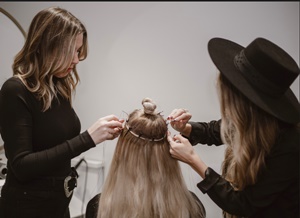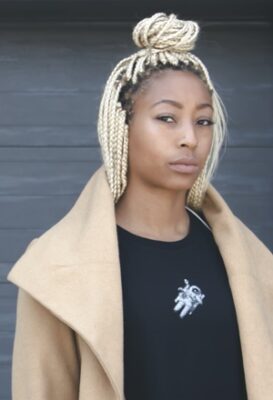
How to Tell If You Have Traction Alopecia Hair Loss
 How to Tell If You Have Traction Alopecia Hair Loss- Gustavo Spindula on Unsplash.com
How to Tell If You Have Traction Alopecia Hair Loss- Gustavo Spindula on Unsplash.comMany people, more often women, select trendy hairstyles which may trigger traction alopecia.
They may know their scalp, roots, and follicles have long-term alopecia risks, but they don't take it seriously.
Definition Of Traction Alopecia
What is traction alopecia or TA? It's progressive hair loss triggered by constant pulling or traction on the hair roots.The root pressure results from wearing tight pony or pigtails, braids, or buns. This alopecia is worsened by repeatedly securing a tight base at the same exact spot on the scalp.
 How to Tell If You Have Traction Alopecia Hair Loss- Nikoka Topic - Unsplash.com
How to Tell If You Have Traction Alopecia Hair Loss- Nikoka Topic - Unsplash.comDevelopment Of Hairline Fringe
As this condition develops and progresses, it's characterized by the development of a signature hairline fringe.
This signature fringe clearly identifies the condition.
Frontal Fibrosing Alopecia
The fringe sign is considered a solid clinical marker in traction alopecia. It may also occur in cases of frontal fibrosing alopecia. This type of alopecia may present with unusual retention of the hairline (pseudo-fringe sign). Fibrosing alopecia is considered to be a clinical variant of lichen planopilaris.
This is not considered to be a type of traction alopecia.
Causes Of Traction Alopecia
 How to Tell If You Have Traction Alopecia Hair Loss
How to Tell If You Have Traction Alopecia Hair LossAccording to the American Academy of Dermatology, occasionally wearing tight hairstyles is not a problem. It only becomes a potential challenge over an extended period of time. Unlike other forms of hair loss, traction alopecia is not a medical concern.
While it can be reversed if caught early, even short-term bouts may have adverse psychological effects.
Some daily hair loss is perfectly normal. Not all people are the same, but in general, humans normally lose between 50 and 100 hairs every day.
The Hairline, Crown, or Nape Are Most At Risk
This is a normal part of the hair growth cycle which cycles between anagen, catagen, telogen, and exogen.
Anything that pulls on the hair ultimately damaging the roots can lead to permanent hair loss. It can literally take hold of your crown, nape, or hairline and trigger major shedding.
Traction Alopecia triggers include, but are not limited to:
- tightly plaited braids
- tautly pulled pony or pigtails from the hairline
- firmly anchored topknots or buns
- hair clips, barrettes, or overwrapped elastics that overextend the base of a style
 How to Tell If You Have Traction Alopecia Hair Loss
How to Tell If You Have Traction Alopecia Hair LossHair extensions, wigs,s and some types of hair wear may be long-term triggers.
- clip-in temporary hair extensions anchored to hair roots
- tape-in hair wefts, which apply persistent pressure to hair roots
- fusion hair extensions add too much weight to the scalp
- wigs with tight caps which apply too much pressure to the scalp
- tight caps or other headwear
Symptoms Of Traction Alopecia
 How to Tell If You Have Traction Alopecia Hair Loss - Daria Rom - Unsplash.com
How to Tell If You Have Traction Alopecia Hair Loss - Daria Rom - Unsplash.comTraction alopecia may start out as thinning or increased shedding along the hairline or the edges. Or it may present as hair thinning along the crown, nape, or other areas of the scalp.
Sometimes Traction alopecia also presents as:
- development of random patches with hair loss
- fine red bumps which may appear to be small pimples or a small rash
- broken hairs around the forehead or along the crown or interspersed throughout the scalp
- scalp feels inflamed, itchy, or loose
- burning
- scaling
- folliculitis (inflammation of the hair follicles)
- pus-filled blisters on your scalp
- parts widen
- patches of shiny scalp skin may show through
Long-Term Is The Key
 How to Tell If You Have Traction Alopecia Hair Loss - Lindsay Cash - Unsplash.com
How to Tell If You Have Traction Alopecia Hair Loss - Lindsay Cash - Unsplash.comThis is an upside to traction alopecia. It can take years for traction alopecia to become a serious irreversible type of hair loss issue. If you think you are at risk of developing traction alopecia, change up your hairstyles. Alternate between looser hairstyles.
Monitor your crown and hairline for telltale symptoms. Address the situation before it does permanent damage. There are several steps you can take to stall or completely reverse traction alopecia.
Traction alopecia is mechanical in the cause. It is unlike other types of genetic or viral-triggered alopecia. Management includes termination of the chronic traction.
 How to Tell If You Have Traction Alopecia Hair Loss
How to Tell If You Have Traction Alopecia Hair LossNon-invasive medical treatments may be successful such as topical or oral alopecia remedies. Surgical restoration is reserved for more severe cases.
Summary - How to Tell If You Have Traction Alopecia Hair Loss
Traction alopecia occurs with hairstyles that pull the hairline forcefully towards the vertex of the scalp. Ethnic women, professional ballerinas, and people wearing heavy hair extensions are at risk.
So are other ethnicities who never cut their hair which may become very heavy. This condition can cause scarring.
Traction alopecia is a substantial risk in hair weaves. They can be worn either to conceal hair loss or purely for cosmetic purposes.
Weaves are sewn onto a tight braid that encircles the hairline. This type of alopecia is one of the most common causes of hair loss in African American women or Sikh men who wear tightly tied turbans for a lifetime.
Luckily it takes a very long time for this type of alopecia to develop, and in many cases, it can be reversed.
There are also an array of both non-invasive and surgical options. They may be utilized in appropriate cases.
Best wishes to all.Social Media Network Information
Please follow us on Twitter at: https://Twitter.com/HairBoutique. I look forward to meeting new people from all walks of Twitter and learning from their Tweets.

















